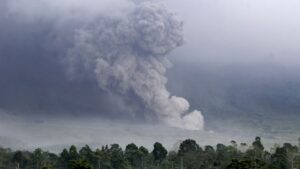
CNN has reported the Indonesian volcano, Mount Semeru, began erupting Sunday at 2.46 am local time prompting evacuations of nearly 2.000 residents in East Java Province.
Video footage from Indonesia’s Disaster Management Agency (BNPB) showed villages covered in ashes while a statement released by the agency said no injuries or deaths had so far been reported. The release added 20.000 face masks had been handed out to mitigate respiratory health risks from volcanic ash.
The agency has further warned residents to stay at least 17 kilometers away from Semeru’s eruption center from which volcanic ash was reported to have reached as far as 12 kilometers.
According to CNN, Indonesia’s Center for Volcano and Geological Hazard Mitigation (PVMBG) released a statement saying the alert level of the eruption had been raised to level four – the highest level – while Japan’s Meterological Agency announced the plume from the eruption reached 15 kilometers into the air and that no tsunami impact followed the eruption.
Mount Semeru is situated around 640 kilometers southeast of the capital Jakarta and is the tallest, most active, volcano on Java. The volcano erupted last year killing 50 people and dispatching an additional thousands.
PVMBG said they expected a larger volume of magma from Semeru compared to the 2021 eruption which is also why the hot clouds from Semeru could potentially reach further.
The eruption follows a series of earthquakes on the western side of the Island of which the most severe killed more than 300 people last month. The heavy underground activity is due to the location of the archipelago on the so-called “ring of Fire”, a horse-shoe shaped belt around much of the rim of the Pacific Ocean where many volcanic eruptions and earthquakes occur because of high tectonic activity from the Eurasian Tectonic Plate.
Tectonic movements is the result of a heat surplus in the Earth’s inner center and gravity. The heat surplus can not be compensated sufficiently by an even and uniform thermal conduction through the crust. This causes convectional currents in the crust which forces the deeper, warmer crust material upwards until it reaches the underside of the lithosphere, braking it into massive plates moving back and forth.
Source: https://edition.cnn.com/2022/12/04/asia/indonesia-semeru-volcano-erupts-intl/index.html


